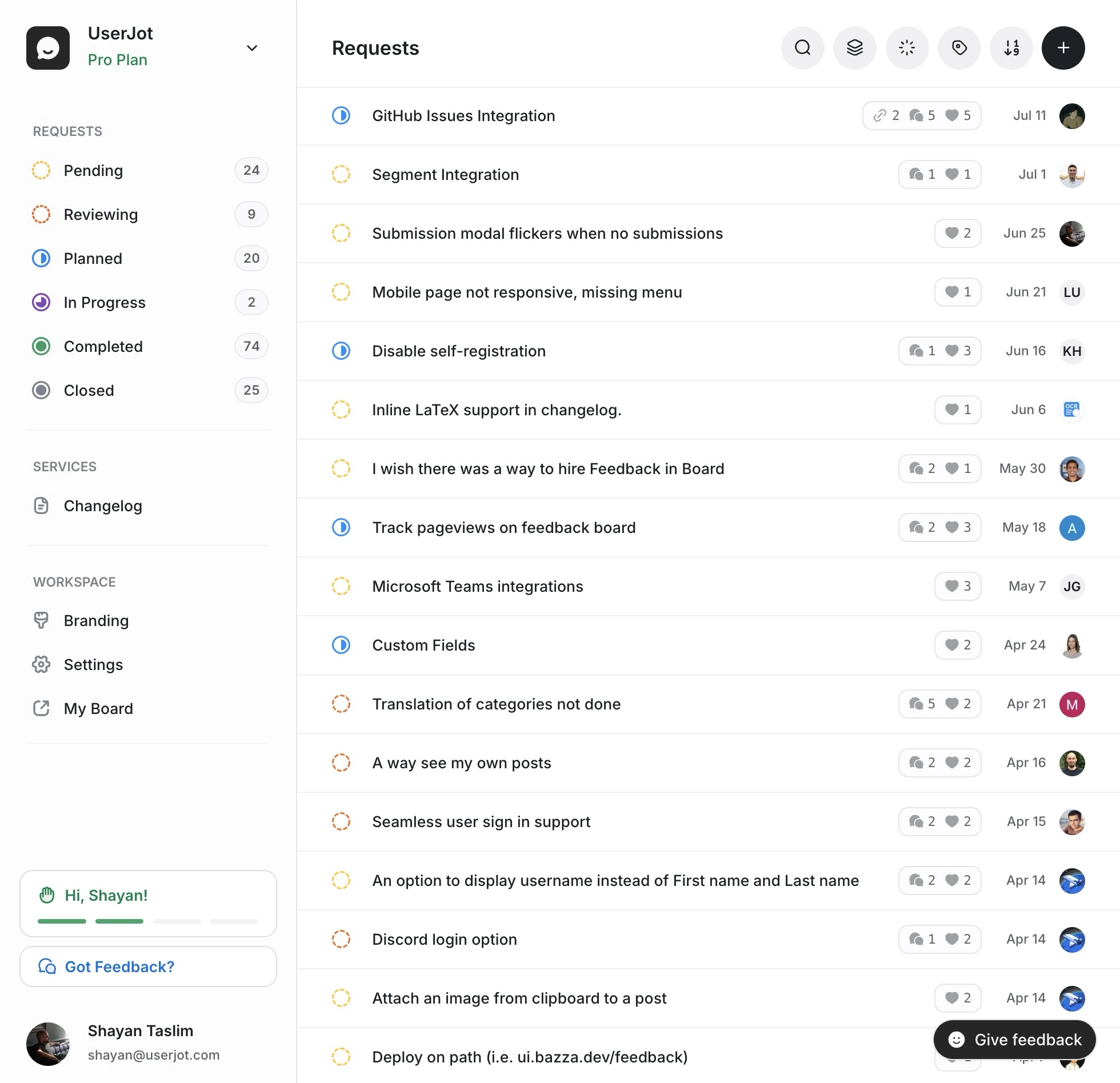Ship in Public: How Transparency Reduces Churn

Most SaaS companies treat their product development like a state secret. Roadmaps hidden in Notion. Features shipping silently. Customers finding out about updates by accident three months later.
Then they wonder why customers churn to competitors who “move faster” or “listen better.”
Here’s the thing: those competitors probably aren’t moving faster. They’re just louder about what they’re building. And that transparency is worth its weight in reduced churn.
I learned this the hard way. At my previous startup, we bled customers who thought we “weren’t building anything new” while we were literally shipping weekly. When we finally made our roadmap public, the “not building anything” churn reason dropped from 40% to 10% in 6 months. That experience led me to build UserJot, but the principles work regardless of your tools.
The Hidden Cost of Secrecy
When you ship in silence, customers fill the void with assumptions:
- “They’re not building anything”
- “They don’t care about our feedback”
- “That competitor seems more innovative”
- “Maybe we should look at alternatives”
These assumptions compound. A customer who thinks you’re stagnant for 3 months starts shopping around. By month 6, they’re gone.
Meanwhile, you’re spending 5+ hours a week answering “when will X be ready?” support tickets and doing damage control on churn calls. All because customers can’t see what you’re actually doing.
What “Shipping in Public” Actually Means
It’s not about sharing your secret sauce or competitive advantages. It’s about basic visibility into:
What you’re building: Public roadmap showing upcoming features (not your algorithms) What you just shipped: Regular changelog updates (not your codebase) What you decided not to build: Honest communication about priorities (not your strategy) Why you made those decisions: Context helps acceptance (not your trade secrets)
Think of it like a restaurant posting “New menu items coming next month.” Creates anticipation without revealing recipes.
The Real Time Investment
Let’s be honest about the actual time this takes:
Initial setup:
- Basic changelog page: 30 minutes
- Simple public roadmap: 1-2 hours
- Feedback visibility system: 2-3 hours
Weekly maintenance:
- Writing changelog: 15-20 minutes
- Updating roadmap: 10 minutes
- Responding to feedback: 30-45 minutes
Total: ~1-2 hours per week
Compare to: 5+ hours weekly on “when will feature X be ready?” support tickets.
You’re not adding work. You’re replacing reactive support with proactive communication.
Minimum Viable Transparency
Start stupidly simple:
Week 1: Email 10 customers about that feature they don’t know exists. Subject: “You asked for CSV export - it’s been live for 2 weeks”
Track: Do support tickets about that feature drop?
Week 2: If yes, publish a basic changelog. Just a list:
### What we shipped this week (Dec 2, 2024)
✨ CSV export for all reports (requested by 12 customers)
🚀 Dashboard loads 2x faster
🐛 Fixed: Date picker now works on Safari
Week 3: Add a simple roadmap:
### What we're building
**Now (December)**
- Advanced filtering
- API v2
**Next (Q1 2025)**
- Slack integration
- Custom fields
**Later**
- Mobile app
- Webhooks
Only add more if this baseline actually reduces support tickets and churn mentions.
Real Examples That Work
Linear: Ships updates weekly, makes it an event. Their changelog is actually interesting to read. Time investment: They have a dedicated person, but the changelog itself takes ~1 hour to write.
Vercel: Public roadmap with voting. Customers literally tell them what to build. Churn dropped significantly after launch (they’ve mentioned this publicly).
Small SaaS Example: My friend’s 5-person analytics startup started posting monthly updates. “Why aren’t you building X?” support tickets dropped 70%. Time: 2 hours monthly.
The Fear Factor (And How to Handle It)
“But what if competitors see our roadmap?”
They already know. Your customers tell them during sales calls. Your ex-employees share it. Plus, you’re not sharing HOW you’re building, just WHAT. Execution matters more than ideas.
“What about enterprise customers who want secrecy?”
Use private roadmaps for them. Same transparency, limited visibility. Many tools support this, or just use a password-protected page.
“What if we don’t deliver on time?”
Never use dates. Use quarters. Say “planned” not “promised.” Add this disclaimer: “Roadmap items are intentions, not commitments. Priorities may shift based on customer feedback.”
“First-mover disadvantage?”
You’re probably not the first in your space to do this. But if you are, you become known as the transparent, customer-focused option. That’s a competitive advantage.
Templates That Actually Work
Changelog Entry Template:
## 🚀 Week of [Date]
### ✨ New Features
- **[Feature Name]**: [1-line description] (requested by X customers)
- Why: [Customer problem it solves]
- How to use: [Link to docs/video]
### 💪 Improvements
- [What you improved]: Now [specific improvement]
- Before: Loading took 3 seconds
- After: Loading takes 1 second
### 🐛 Bug Fixes
- Fixed: [Specific bug description]
Roadmap Item Template:
### [Feature Name]
**Status**: Planned for Q2 2025
**Requested by**: 47 customers
**Why**: [Problem it solves]
**Workaround until then**: [Current solution]
Dealing With Public Complaints
Yes, someone will eventually post “This product is too basic for real companies” on your public feedback board.
Here’s what happens:
- Other customers often defend you
- The complainer usually elaborates on specific needs
- You get invaluable product feedback
- Prospects see how you handle criticism
Template response: “Thanks for the honest feedback. Could you elaborate on what ‘enterprise-ready’ means for your team? We’re actively working on [relevant feature] for Q1.”
The Compound Effect (With Realistic Timeline)
Month 1: Setup phase. Customers go “Oh, you have a changelog now.” Some engagement.
Month 2-3: Trust building. “When will X be ready?” tickets start dropping. Maybe 20-30% reduction.
Month 4-6: Word spreads internally at customer companies. “Hey, did you see they’re building Y?”
Month 6-12: Becomes part of your reputation. Sales mentions it as a differentiator. Churn calls shift from “you’re not building” to actual product gaps.
Year 2+: Compound benefits. Churned customers watch your changelog and sometimes return.
Don’t expect overnight miracles. This is a long game that pays compound dividends.
Tools Don’t Matter (But They Help)
You can start with:
- Changelog: GitHub releases, simple blog, even a Google Doc
- Roadmap: Trello, Notion (make it public), Airtable
- Feedback: Google Forms → Spreadsheet (ugly but works)
Purpose-built tools save time by:
- Automating status update emails
- Connecting feedback → roadmap → changelog
- Handling upvoting and duplicate detection
We built UserJot to reduce the weekly time to ~30 minutes, and the core features (feedback, roadmap, changelog) are free. Start there or with other free tools - just start somewhere and upgrade to paid features when you need them.

Stop guessing what to build. Let your users vote.
Try UserJot freeThe Uncomfortable Truth
Some customers will still churn. If your product genuinely doesn’t solve their problem, transparency won’t save them.
But here’s what changes: instead of customers leaving because they think you’re not building anything, they leave with clear feedback about what’s actually missing. That’s infinitely more valuable.
Plus, I’ve seen churned customers return after watching public changelogs. They see you built what they needed and come back. Silent shippers never get that second chance.
When NOT to Ship in Public
Let’s be real. Skip this if:
- You’re in stealth mode or building something truly novel
- You change direction weekly (figure out your vision first)
- You have fewer than 10 customers (just talk to them directly)
- Your product has fundamental issues (fix those first)
Transparency amplifies what you have. If what you have is broken, fix that first.
Start Today (Seriously, Today)
- List 3 features you shipped in the last month that customers don’t know about
- Email 10 customers about ONE of them
- Track replies and support ticket changes
- If positive, do it again next week
That’s it. No tools needed. No grand strategy. Just start communicating what you’re already doing.
Remember: customers don’t need perfection. They need progress they can see.
FAQ
What does “shipping in public” mean?
Shipping in public means being transparent about what you’re building, what you’ve shipped, and what you’re planning. It includes public roadmaps, regular changelog updates, and honest communication about product decisions. Not your code or algorithms, just your progress.
How does transparency reduce churn?
Customers leave when they think you’re not building anything or not listening. When they can see constant progress and their requested features on your roadmap, they’re more patient. In my experience, “not building anything” churn reasons can drop from 40% to 10%.
How much time does shipping in public actually take?
Initial setup: 2-4 hours total. Weekly maintenance: 1-2 hours (changelog writing, roadmap updates, responding to feedback). This usually replaces 5+ hours of “when will X be ready?” support tickets.
Should startups share their roadmap publicly?
Yes, with caveats. Use quarters not dates. Say “planned” not “promised.” Add disclaimers about priorities changing. Skip if you’re in stealth mode or pivot weekly.
What if competitors see our public roadmap?
They likely already know through customers and employees. You’re sharing WHAT you’re building, not HOW. It’s like a restaurant announcing new menu items without revealing recipes. Execution matters more than ideas.
What about enterprise customers who need privacy?
Offer private roadmaps with same transparency but limited visibility. Many tools support this, or use password-protected pages. They get the benefits without public exposure.
What tools do I need to ship in public?
Start free: GitHub releases, Google Docs, Trello boards. Upgrade to purpose-built tools when manual work takes too much time. Focus on consistency over fancy tools.
How do I handle negative public feedback?
Respond professionally and ask for specifics. Other customers often defend good products. Public complaints become valuable product insights. Show prospects how you handle criticism.
When should I NOT ship in public?
Skip if: you’re in stealth mode, pivot weekly, have < 10 customers, or have fundamental product issues. Fix core problems first. Transparency amplifies what you have.
What’s a good changelog format?
Keep it simple: New features (with who requested), improvements (with specific metrics), bug fixes. Use emojis for scanning. Link to documentation. Show impact, not just changes.